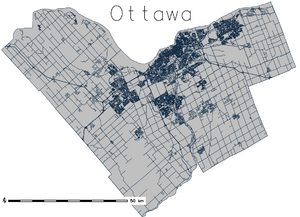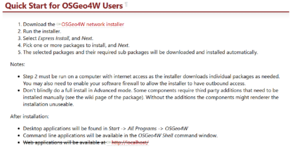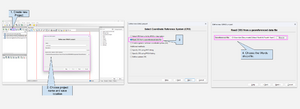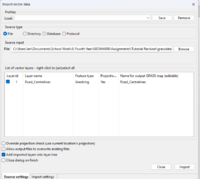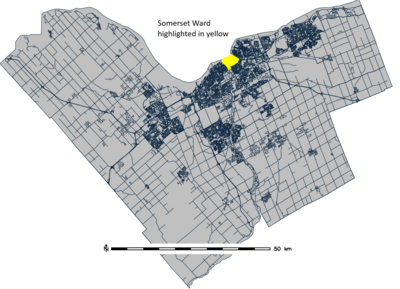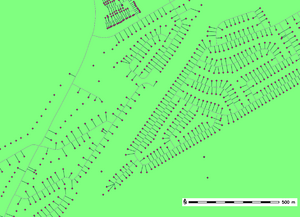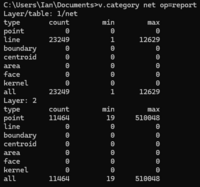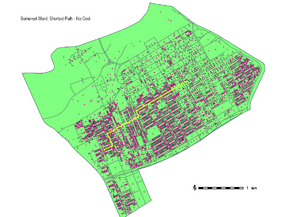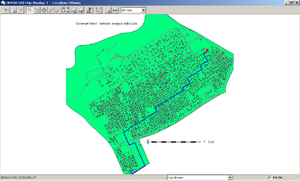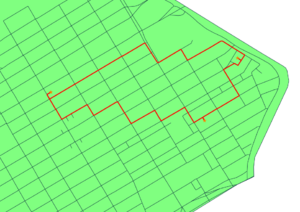Difference between revisions of "Traveling Salesman Problem (TSP)"
(→Data) |
IanShintani (talk | contribs) m (IanShintani moved page Travelling Salesman Problem (TSP) to Traveling Salesman Problem (TSP) over redirect) |
||
| (166 intermediate revisions by 3 users not shown) | |||
| Line 1: | Line 1: | ||
== '''Introduction''' == |
== '''Introduction''' == |
||
| − | ::[[File: |
+ | ::[[File:OttawaUpdated.png|thumb|right|Ottawa]] |
This is a Free and Open Source Software for Geospatial (FOSS4G) inspired tutorial. It focuses on Network Analysis using a Geographic Resources Analysis Support System [http://grass.osgeo.org/ (GRASS).] |
This is a Free and Open Source Software for Geospatial (FOSS4G) inspired tutorial. It focuses on Network Analysis using a Geographic Resources Analysis Support System [http://grass.osgeo.org/ (GRASS).] |
||
==== About the Tutorial ==== |
==== About the Tutorial ==== |
||
| − | This tutorials' main aim is to be clear and understandable. I made every effort to use real data even though this presents many problems. However, it is a reality that data is dirty and software is |
+ | This tutorials' main aim is to be clear and understandable. I made every effort to use real data even though this presents many problems. However, it is a reality that data is dirty and software is fallible. This tutorial will be very time consuming to complete, however, you will learn a lot along the way and this knowledge will easily transfer to future projects. |
In this tutorial you will |
In this tutorial you will |
||
| Line 13: | Line 13: | ||
* Build a network and perform analysis on it |
* Build a network and perform analysis on it |
||
| + | == '''Software Installation and Data Downloads''' == |
||
| + | ===Software Installation=== |
||
| − | |||
| + | ::[[File:QuickStart.png|300px|right|thumb|Quick Start]] |
||
| − | ''Note'' |
||
| + | ==== Install OSGEO Package (30-60mins)==== |
||
| − | ''If the command line is not working and you don’t wish to take the time to troubleshoot this problem I have been given a great work around from my teacher Scott Mitchell. If you do not have GRASS folders set up refer to step named '''Getting on our way.''''' |
||
| + | First, you will need to install free geospatial software. I am mainly using GRASS 8.4.0 (originally created using 6.4.2). This can be found through the secure and trusted site of [http://www.osgeo.org/ Open Source Geospatial Foundation] |
||
| − | *''1. Launch the OSGeo4W'' |
||
| − | *''2. Type '''grass64 –gui''' and then hit enter on the keyboard. (notice there is a space between 64 and the dash)'' |
||
| − | *''3. You will see the old GRASS version load, so simply click '''File''' from the menu bar and click '''Quit GIS Manager'''.'' |
||
| − | *''4. Now in the command box type '''g.gui gui=wxpython&''''' |
||
| − | |||
| − | == '''Installation''' == |
||
| − | |||
| − | ==== Install OSGEO Package (30-60mins)==== |
||
| − | [[File:QS.png|200px|right|thumb|Quick Start]] |
||
| − | First, you will need to install free geospatial software. I am using GRASS 6.4.2. This can be found through the secure and trusted site of [http://www.osgeo.org/ Open Source Geospatial Foundation] |
||
OSGeo4w is ''Your Open Source Compass for Windows'' |
OSGeo4w is ''Your Open Source Compass for Windows'' |
||
This package provides a set of open source geospatial software for a Win32 environment. |
This package provides a set of open source geospatial software for a Win32 environment. |
||
Simply follow the directions from this site: [http://trac.osgeo.org/osgeo4w/ Click Here to go to Download Page] |
Simply follow the directions from this site: [http://trac.osgeo.org/osgeo4w/ Click Here to go to Download Page] |
||
| − | The great thing about this pkg is that is contains several versions of GRASS. So if something |
+ | The great thing about this pkg is that is contains several versions of GRASS. So if something doesn't work in one version it might work in another. |
| − | ==== |
+ | ==== Grass Tutorials==== |
| − | [ |
+ | [https://grass-tutorials.osgeo.org// Grass Tutorials ] This website has tutorials on Getting Started and a variety of other tutorials with different difficulty levels. The getting started tutorials allow for an increased understanding of the software, though it is not necessary to complete it in full. |
| + | |||
| + | === Data Download === |
||
| + | To get started we need to download data required for the tutorial. |
||
| + | *Go to [https://open.ottawa.ca/ The City of Ottawa, Open Data Site] |
||
| + | *Download the Wards 2022-2026 shapefile. You can find it [https://open.ottawa.ca/datasets/ottawa::wards-2022-2026/explore here] |
||
| + | *Download the Road Centrelines shapefile. You can find it [https://open.ottawa.ca/datasets/ottawa::road-centrelines/explore here] |
||
| + | *Download the Municipal Addresses csv file. You can find it [https://open.ottawa.ca/datasets/ottawa::municipal-address-points/explore here] |
||
| + | |||
| + | Once downloaded, Unzip if necessary and add the unzipped folder to a folder named data and save it in a location that you will also ideally use to save the project. |
||
| + | * '''Make sure to rename all files in the wards layer to just wards.xx''' |
||
| + | * Also rename the municipal_address_point.csv to Addresses.csv |
||
== '''The Tutorial''' == |
== '''The Tutorial''' == |
||
====Getting Started: GRASS Database (just minutes)==== |
====Getting Started: GRASS Database (just minutes)==== |
||
| − | ::[[File: |
+ | ::[[File:CreateProject.png|thumb|Screenshots guiding project creation in GRASS]] |
| + | 1. Open GRASS |
||
| − | 1. Prior to starting a GRASS session, create a New Folder named Grassdata and a second named nonGrassData, on your Windows Desktop. Then start GRASS and once the screen opens, browse to the Grassdata folder. Ensure all file and folder names contain NO spaces, that they are short, and do not begin with numbers. |
||
| + | |||
| + | 2. Once opened. On the left hand side in the Data tab click on [[File:NewProjectIcon.png]] to create a new project. |
||
| + | |||
| + | 3. Within the "Define new GRASS project" tab, name the project and choose a location on your computer where you would like to save it. Click Next. |
||
| + | |||
| + | 4. On the select Coordinate Reference System (CRS) page, choose "Read CRS from a georeferenced data file" and click Next. |
||
| + | 5. You should now see a prompt asking for a georeferenced data file. Locate the folder in which you saved the data you downloaded from OpenOttawa and choose the '''wards.shp''' file. |
||
| − | 2. Push the button for Georeferenced files, name the newLocation Ottawa and then browse to the nonGrassData folder. Select the Roadways.shp file. Now click define. |
||
| + | 6. Click Next and then Finish. |
||
| − | 3. Click on both '''Ottawa''' and then PERMANENT in each of the grey boxes and then push the '''ENTER GRASS''' button. |
||
| + | <br> |
||
| + | <br> |
||
Now we are ready to start working in GRASS. |
Now we are ready to start working in GRASS. |
||
| + | <br> |
||
| + | <br> |
||
| + | <small>Next:Import data files and prepare them for processing and analysis</small> |
||
| + | ==== Importing .shp ==== |
||
| − | Next:Import data files and prepare them for processing and analysis |
||
| + | [[File:importshp.png|200px|thumb|Screenshot of the Import Vector Data tool popup]] |
||
| + | '''1.''' You now have GRASS running with the GIS view and command prompt open in another window. In the GIS view along the top ribbon click '''File | Import Vector Data |Simplified vector import with reprojection [v.import]'''. |
||
| − | ==== Importing .shp ==== |
||
| + | '''2.''' A GUI window will appear to lead you forward. In the source input section browse to the data folder and choose Road_Centrelines.shp file and then run. If you watch the Layer Manager window it will tell you when all is complete. At the bottom of the window you will have to hit the Map Layers tab as you have been watching the command console tab. |
||
| − | '''1.''' You now have three screens open and running under GRASS. A command line black box, a GRASS GIS Layer Manager, and a Map Display pane. In the Layer Manager window click '''File | Import Vector Data |Common Import Formats'''. |
||
| − | |||
| − | '''2.''' A GUI window will appear to lead you forward. Choose Roadways.shp from the drop down menu and push Run. If you watch the Layer Manager window it will tell you when all is complete. At the bottom of the window you will have to hit the Map Layers tab as you have been watching the command console tab.[[File:tabs.png|100px|thumb]] |
||
| − | '''3.''' Now the |
+ | '''3.''' Now the Road_Centrelines file is loaded to the Layer Manager window simply toggle it on to view it in the Map Display window. |
| − | '''Next''' do the same for the |
+ | '''Next''' do the same for the Wards.shp file. You can skip this step if you noticed that Wards is already in the Data section. If that was the case, double click on Wards to add the layer to the map. |
==== Importing .csv ==== |
==== Importing .csv ==== |
||
| − | This is not as straight forward as the .shp files. You must first open the Addresses.csv file in |
+ | * This is not as straight forward as the .shp files. You must first open the Addresses.csv file in Microsoft Excel for editing. |
| − | |||
| − | When OpenOffice asks which format the file is in pick the one that has ASCII. Then toggle on: 'separted by commas' and untoggle anything else like periods or spaces ect. In the preview box at the bottom it should now display a more normal spaced looking file. [[File:OO.png|Calc|right|thumb]] |
||
| + | * When Excel asks if you would like to remove leading zeros choose convert. |
||
| − | Edit all the column headings to simple, short, alphabetical names with no spaces. Delete unnessary columns. Leave the first one, pin number,addressNumber,road names and the x and y coordinate columns. You have six columns now. |
||
| + | * Delete all columns in the table except for X, Y, OBJECTID, ADDRNUM, ROAD_NAME, and WARD |
||
| − | The x,y columns need to be formated. You can use the 'Find and Replace' tool. First replace all commas with periods. Then right justify the x and y columns. These are necessary steps. |
||
| + | * The x,y columns need to be formatted. You can use the 'Find and Replace' tool. First replace all commas with periods. Then right justify the x and y columns. These are necessary steps. |
||
| − | Save the file as a .csv. OpenOffice might say that there is a problem, just ignore it. |
||
| + | * Save the file as a .csv. Excel might say that there is a problem, just ignore it. |
||
| − | To bring it into GRASS: |
||
| + | [[File: ExcelAddress.png|Example Format of Addresses.csv in Excel|right|thumb]] |
||
| − | :Click File|Import vector data|ASCII points/GRASS ASCII vector import [v.in.ascii] |
||
| + | * To bring it into GRASS: |
||
| + | :Click File|Import vector data|ASCII points/GRASS ASCII format [v.in.ascii] |
||
| − | Under the Required Tab: |
+ | * Under the Required Tab: |
| − | :Browse to the file and choose it. Then back in the GUI, name the output file. |
+ | :Browse to the Addresses.csv file and choose it. Then back in the GUI, name the output file Addresses. |
| − | Under the |
+ | * Under the Input Format Tab: |
| − | :Change the Field |
+ | :Change the Field Separator from pipe to comma in the dropdown menu. |
| − | Under the Points Tab: |
+ | * Under the Points Tab: |
:Number of header lines to skip: 1 |
:Number of header lines to skip: 1 |
||
| − | :Number of column used for x: |
+ | :Number of column used for x: 2 (Make sure this number matches the column number in which your x values are located in) |
| − | :Number of column used for y : |
+ | :Number of column used for y : 3 (Make sure this number matches the column number in which your y values are located in) |
| − | :Number column used for category: 1 |
+ | :Number column used for category / id : 1 (Make sure this matches the column number where the global id is) |
:Hit Run |
:Hit Run |
||
==== Processing in Grass ==== |
==== Processing in Grass ==== |
||
| − | Type this in the command line box, it will adjust the region parameters. |
+ | * Type this in the command line box, it will adjust the region parameters. |
| − | g.region -p vect= |
+ | g.region -p vect=Road_Centrelines |
| − | Next extract the location you specifically wish to focus on. In this case it will be the Somerset ward. |
+ | * Next extract the location you specifically wish to focus on. In this case it will be the Somerset ward. |
| + | ''make sure that cat = 1 is the Somerset ward. You can check by opening up the attribute table of the wards layer and checking the cat value for Somerset ward.'' |
||
| − | v.extract input=Wards output=Somerset type=area where=cat=16 |
||
| + | v.extract input=Wards output=Somerset type=area where=cat=1 |
||
| − | Next extract the customers that are within that ward from the larger customer data set. |
||
| + | [[File:Somerset.png|400px|center|thumb| Somerset Ward highlighted]] |
||
| − | v.select ainput=Addresses atype=point binput=Somerset type=area output=addSomerset |
||
| + | * Next extract the customers that are within that ward from the larger customer data set. |
||
| − | operator=within |
||
| + | v.select ainput=Addresses atype=point binput=Somerset btype=area output=addSomerset operator=within |
||
| − | Next extract the Roadways |
||
| + | * Next extract the Road Centrelines |
||
| − | v.overlay ainput=Roadways atype=line binput=Somerset output=SomerRoads operator=and |
||
| + | v.overlay ainput=Road_Centrelines atype=line binput=Somerset output=SomerRoads operator=and |
||
| + | If you would like to see the outputs. In the GIS window refresh the Data pane and double click on the new layers created to add them to the map. |
||
| − | ==== Network Preperation ==== |
||
| + | |||
| − | Type this in the command line box, it will adjust the region parameters. |
||
| + | ==== Network Preparation ==== |
||
| + | * Type this in the command line box, it will adjust the region parameters. |
||
g.region -p vect=Somerset |
g.region -p vect=Somerset |
||
| − | Next ''clean'' the data |
+ | * Next ''clean'' the data |
v.clean input=SomerRoads output=SomerRoadCl type=line tool=break,rmdupl |
v.clean input=SomerRoads output=SomerRoadCl type=line tool=break,rmdupl |
||
| − | |||
==== Extract a Start point ==== |
==== Extract a Start point ==== |
||
| + | Before we start this part. Remove all layers currently in the layers section. Then refresh the Data tab. |
||
| − | When you right click on the addSomerset layer in the Layer Manager window, select to veiw the Attribute table. Scroll to find the exact address you want to use and note its 'cat#', which will be the one in the first coloum for the row you choose, you will need to input that number later in the GUI. We will use the GUI for the next 2 extrations. |
||
| + | Once you refresh the data pane in the GIS add the following layers to the map by double clicking on it in the data pane. |
||
| − | :Click on menue bar: Vector|Feature selection|Query with attributes |
||
| + | * Somerset |
||
| − | :Browse to the addSomerset file and choose it |
||
| + | * SomerRoadsCl |
||
| − | :Name the output map as: Start |
||
| + | * addSomerset |
||
| + | '''Now we can begin''' |
||
| + | * When you right click on the addSomerset layer in the Layer Manager window, select to view the Attribute table. Scroll to find the exact address you want to use and note its 'category' number, which will be the one in the first column for the row you choose, you will need to input that number later in the GUI. We will use the GUI for the next 2 extractions. '''Note: the category number may be the int_1 number''' |
||
| + | * On the menu bar (Top ribbon) choose the following:''' Vector|Feature selection| Select by Attributes [v.extract]''' |
||
| + | * Once the tool is open browse to the addSomerset file and choose it for the input vector map |
||
| + | * Name the output map as: Start |
||
| − | In the next tab: Selection |
+ | In the next tab: Selection (in the same tool) |
| − | + | * In the types to be extracted section choose: point |
|
| − | + | * In the Where conditions of SQL type section write the following: cat= '''category number''' ''(The point you chose in the first step) or 40698'' |
|
| + | ** If the above step didn't work change the '''cat=''' # to '''int_1'''= #. <small>Or to whatever the field name is for the first field in your addSomerset layer.</small> |
||
| − | :click Run but do not close the window!!! |
||
| + | * Click Run but do not close the window!!! |
||
Next extract all other points minus the one we just extracted. |
Next extract all other points minus the one we just extracted. |
||
| − | + | * All you need to do is simply toggle back to the first tab to change the output name to Customers. |
|
| − | + | * And then in the Selection tab: toggle on the Reverse Selection option and it will do the rest. |
|
| − | + | * Hit run and close when done. |
|
==== Attribute Editing ==== |
==== Attribute Editing ==== |
||
We know that the homes are not located directly on top of the roads so we must calculate and attach them to the network for processing and analysis. First we will create 3 new columns in the attribute tables and then populate them. |
We know that the homes are not located directly on top of the roads so we must calculate and attach them to the network for processing and analysis. First we will create 3 new columns in the attribute tables and then populate them. |
||
| − | v.db. |
+ | v.db.addcolumn map=Customers columns="x double precision,y double precision,dist int" |
| − | v.db. |
+ | v.db.addcolumn map=Start columns="x double precision,y double precision,dist int" |
| − | v.to.db map=Start type=point option=coor columns=x,y |
+ | v.to.db map=Start type=point option=coor columns=x,y --overwrite |
| − | v.to.db map=Customers type=point option=coor columns=x,y |
+ | v.to.db map=Customers type=point option=coor columns=x,y --overwrite |
v.distance from=Start to=SomerRoadCl to_type=line upload=dist column=dist |
v.distance from=Start to=SomerRoadCl to_type=line upload=dist column=dist |
||
| Line 138: | Line 160: | ||
==== Connect Customers to the Network ==== |
==== Connect Customers to the Network ==== |
||
| − | Once we have the distance from all points to the roads,connect all the addresses to the road-network according to a threshold (distance) |
+ | * Once we have the distance from all points to the roads, connect all the addresses to the road-network according to a threshold (distance) |
v.net input=SomerRoadCl points=Start output=network_v2 operation=connect thresh=10 |
v.net input=SomerRoadCl points=Start output=network_v2 operation=connect thresh=10 |
||
| − | v.net input=network_v2 points=Customers output=net operation=connect thresh=50 |
+ | v.net input=network_v2 points=Customers output=net operation=connect thresh=50 |
| + | You can view the network by adding net to the map. |
||
| − | |||
| − | [[File: |
+ | [[File:network.png|thumb|center|Click to see the connections. Customers are pink, Roads are grey, Connections are black]] |
| + | * We can view information about the network |
||
| − | [[File:repor.png|Report|200px|thumb]] |
||
| − | we can view information about the network |
||
v.category net op=report |
v.category net op=report |
||
| + | [[File:reportnew.png|Report|200px|thumb|center]] |
||
| − | |||
| − | |||
| − | |||
| − | |||
==== '''Network Analysis Examples:''' ''Shortest path, no cost'' ==== |
==== '''Network Analysis Examples:''' ''Shortest path, no cost'' ==== |
||
We have a start point, now it is time to choose a destination. Once again choose the 'cat#' of an address point, as you did earlier, using the attribute table from Customers. |
We have a start point, now it is time to choose a destination. Once again choose the 'cat#' of an address point, as you did earlier, using the attribute table from Customers. |
||
| + | * if cat=# didn't work before, change the cat to either int_1 or whatever worked for you in the previous step |
||
v.extract input=Customers output=End type=point where=cat=44017 |
v.extract input=Customers output=End type=point where=cat=44017 |
||
| + | |||
| − | Open the Attribute tables for both the Start point layer and the End point layer. |
||
| + | Refresh the data tab and add the Start and End layers. Then open the Attribute tables for both the Start point layer and the End point layer. [[File:odfile.png|right|300px|thumb|Example of the od.txt file]] |
||
Open Notepad to make a .txt file of these layer's x,y coordinates. |
Open Notepad to make a .txt file of these layer's x,y coordinates. |
||
| − | : Format is: [[File: |
+ | : Format is: [[File:od_type.png]] |
| + | You will get the Start and End layer's x and y coordinates from their respective attribute tables. This is a finicky process, be sure not to put any extra spaces. Also do not hit the return key after you type the last number. If you do simply you the backspace key and delete everything up til the last number entered. Save the file as od.txt |
||
| − | |||
| − | You will get the Start and End layer's x and y coordinates from their respective attribute tables. This is a finicy process, be sure not to put any extra spaces. Also do not hit the retun key after you type the last number. If you do simply you the backspace key and delete everything up til the last number entered. Save the file as od.txt [[File:nocost.png|thumb|Shortest Path No-Cost]] |
||
v.net.path input=net output=route_nocost type=line file=od.txt |
v.net.path input=net output=route_nocost type=line file=od.txt |
||
| − | If you get an error then use the GUI found under Vector|Network Analysis|Shortest path. Or retype the code and in front of od.txt put its full address, like: ''file=/home/desktop/od.txt'' |
+ | If you get an error then use the GUI found under Vector|Network Analysis|Shortest path. Or retype the code and in front of od.txt put its full address, like: ''file=/home/desktop/od.txt''. You may also need to add --overwrite at the end. |
| + | * A trick to get the full address is to find the file, right click on it and copy as path. |
||
| + | |||
| + | Once this finished building, you cand refresh the data tab in the GIS and add route_nocost to the map to view the output. |
||
| + | |||
| + | [[File:ShortestPath.png|300px|thumb|Shortest Path No-Cost|center]] |
||
==== '''Network Analysis Examples:''' ''Shortest path, with costs'' ==== |
==== '''Network Analysis Examples:''' ''Shortest path, with costs'' ==== |
||
| + | '''Note: I have attempted this example in GRASS 8.4.0 and I ran into errors. Feel free to still try this example.''' |
||
| − | First add two new coloums to the network file. |
||
| + | |||
| − | v.db.addcol map=net columns='saftey int,cost int' |
||
| + | First add two new columns to the network file. |
||
| + | v.db.addcolumn map=net columns="safety int,cost int" |
||
Next create at .txt file in Notepad |
Next create at .txt file in Notepad |
||
| + | |||
| − | UPDATE Routes SET saftey=1 WHERE RD_SUFFIX='ST'; |
||
| − | UPDATE |
+ | UPDATE net SET safety=1 WHERE a_SUFFIX_EN='St'; |
| − | UPDATE |
+ | UPDATE net SET safety=1 WHERE a_SUFFIX_EN='Ave'; |
| − | UPDATE |
+ | UPDATE net SET safety=1 WHERE a_SUFFIX_EN='Crt'; |
| − | UPDATE |
+ | UPDATE net SET safety=1 WHERE a_SUFFIX_EN='Cres'; |
| − | UPDATE |
+ | UPDATE net SET safety=1 WHERE a_SUFFIX_EN='Drwy'; |
| − | UPDATE |
+ | UPDATE net SET safety=1 WHERE a_SUFFIX_EN='Lane'; |
| − | UPDATE |
+ | UPDATE net SET safety=100 WHERE a_SUFFIX_EN='Pkwy'; |
| − | UPDATE |
+ | UPDATE net SET safety=100 WHERE a_SUFFIX_EN='Pky'; |
| − | UPDATE |
+ | UPDATE net SET safety=1 WHERE a_SUFFIX_EN='Pl'; |
| − | UPDATE |
+ | UPDATE net SET safety=1 WHERE a_SUFFIX_EN='Priv'; |
| − | UPDATE |
+ | UPDATE net SET safety=1 WHERE a_SUFFIX_EN='Dr'; |
| + | UPDATE net SET safety=1 WHERE a_SUFFIX_EN='Rd'; |
||
| + | UPDATE net SET safety=1 WHERE a_SUFFIX_EN='Way'; |
||
| + | UPDATE net SET safety=1 WHERE a_SUFFIX_EN='Terr'; |
||
| + | UPDATE net SET safety=1 WHERE a_SUFFIX_EN='Cir'; |
||
| + | UPDATE net SET safety=100 WHERE a_FULL_ROADN LIKE '%HWY%'; |
||
| + | UPDATE net SET safety=100 WHERE a_FULL_ROADN LIKE '%Highway%'; |
||
| + | UPDATE net SET safety=100 WHERE a_FULL_ROADN LIKE 'Turn Lane'; |
||
| + | UPDATE net SET safety=100 WHERE a_FULL_ROADN LIKE '%Driveway%'; |
||
| + | UPDATE net SET safety=1 WHERE a_FULL_ROADN LIKE '%Gt%'; |
||
| + | UPDATE net SET safety=1 WHERE a_FULL_ROADN LIKE '%Gr%'; |
||
| + | UPDATE net SET safety=1 WHERE a_FULL_ROADN LIKE '%Blvd%'; |
||
| + | UPDATE net SET safety=100 WHERE a_FULL_ROADN LIKE 'Transitway'; |
||
| + | UPDATE net SET safety=100 WHERE a_FULL_ROADN LIKE 'Ramp'; |
||
| + | UPDATE net SET safety=1 WHERE a_FULL_ROADN LIKE '%Pk%'; |
||
| + | UPDATE net SET safety=10 WHERE a_FULL_ROADN LIKE '%Bay%'; |
||
| + | |||
| + | *'''Note: There may be additional a_SUFFIX_EN & a_FULL_ROADN types. Check in the attribute table to make sure that a_SUFFIX_EN and a_FULL_ROADN are the proper field names and that you aren't missing any additional suffix's or names. |
||
Now you can |
Now you can |
||
| − | :1 Save the .txt as saftey.txt and then rename the |
+ | :1 Save the .txt as saftey.txt and then rename the extension safety.sql and then use the command line to execute it, if you know the address. |
| − | db.execute input=/home/desktop/ |
+ | db.execute input=/home/desktop/safety.sql |
:2. OR you can open the GUI under the menu Database|Query|SQL statement |
:2. OR you can open the GUI under the menu Database|Query|SQL statement |
||
:Simply copy and paste the UPDATE arguments from above in the space provided, and hit run |
:Simply copy and paste the UPDATE arguments from above in the space provided, and hit run |
||
| − | :This is what I did but I had to do all steps in GRASS6.5 as it didnt work in 6.4.2 |
||
| − | Now that the saftey coloumn has been updated we can preform a cost related analysis. You will notice the non-residential like streets have a high cost and the residentials have a low cost. The calculation will search for the shortest path with the highest saftey rating. |
||
| + | Now that the safety column has been updated we can perform a cost related analysis. You will notice the non-residential like streets have a high cost and the residential have a low cost. The calculation will search for the shortest path with the highest safety rating. [[File:cost.png|Safest Route|thumb|right]] |
||
| − | Now you can calulate with costs by either: |
||
| + | |||
| − | v.net.path input=net output=route_to_libraries_withcost file=/home/desktop/od.txt afcolumn=saftey dmax=10000 |
||
| + | Now you can calculate with costs by either: |
||
| − | if you know the address of the od.txt file :[[File:cost.png|Safest Route|thumb|right]] |
||
| + | v.net.path input=net output=route_to_libraries_withcost file=/home/desktop/od.txt afcolumn=safety dmax=10000 |
||
| + | if you know the address of the od.txt file : |
||
:OR by using the GUI at Vector|Network Analysis|Shortest path |
:OR by using the GUI at Vector|Network Analysis|Shortest path |
||
| + | I followed these instructions but the example didn't work for me in GRASS 8.4.0. It previously worked for the creator of this tutorial using GRASS 6.5 |
||
| − | ==== '''Network Analysis Examples:''' '' |
+ | ==== '''Network Analysis Examples:''' ''Travelling Salesman Problem'' ==== |
| + | Clean a new roads file for use in this section of the tutorial |
||
| + | * You can do this by entering: |
||
| + | v.clean input=SomerRoads output=RoadsClean_TS type=line tool=break,rmdupl |
||
If you have a set of points that you must travel to, extract them into a file of their own. |
If you have a set of points that you must travel to, extract them into a file of their own. |
||
| + | * You can do this by: |
||
| − | Clean a new roads file for use |
||
| + | v.extract input=customers output=TS_Point where="int_1 IN (258, 971, 66, 2027, 2691)" |
||
| − | Connect the two layers as we did earlier |
||
| + | *You can change the where clause to include as many addresses you would like to map out. The addresses are identified using the 'int_1' or 'cat' number. |
||
| + | * ''Note: If int_1 isn't the field name of your category field change int_1 to cat or the name of your category field.'' |
||
| + | Connect the two layers (Network and set of points that you would like to travel to) as we did earlier |
||
| + | * You can do this by: |
||
| + | v.net input=RoadsClean_TS points=TS_Point output=network_TS operation=connect thresh=10 |
||
| + | followed by |
||
| + | v.net input=network_TS points=TS_Point output=net_TS operation=connect thresh=50 |
||
:Run a report on the network to discover the min and max of the second layer |
:Run a report on the network to discover the min and max of the second layer |
||
| − | v.category |
+ | v.category net_TS op=report |
| + | *''Change net_TS to your network name if you used alternative name'' |
||
Run the Traveling Salesman Analysis |
Run the Traveling Salesman Analysis |
||
:''put the min and the max from the report for layer 2. '''ccats=8-21''' is just an example of how you should type it'' |
:''put the min and the max from the report for layer 2. '''ccats=8-21''' is just an example of how you should type it'' |
||
| − | v.net.salesman input= |
+ | v.net.salesman input=net_TS output=salesman_nocost ccats=8-21 |
| + | |||
| + | [[file: Salesman.png| center|thumb| Example of travelling salesman route output]] |
||
| − | ==== '''Network Analysis Examples: |
+ | ==== '''Network Analysis Examples: Want more? Here is another great tutorial ==== |
http://jcastellssala.wordpress.com/2012/05/07/basic-network-analysis-with-grass/ |
http://jcastellssala.wordpress.com/2012/05/07/basic-network-analysis-with-grass/ |
||
| Line 224: | Line 281: | ||
== '''Data''' == |
== '''Data''' == |
||
| + | Data was retrieved form the OpenOttawa data portal. The layers that were used in this tutorial included Road_Centrelines, Wards 2022-2026, and Municipal Address Points. |
||
| − | *Go to [http://app06.ottawa.ca/en/city_hall/statisticsdata/opendata/info/ The city of Ottawa, Open Data Site] |
||
| − | *Download the .csv file Address Points (main) [http://app06.ottawa.ca/cs/groups/content/@webottawa/documents/pdf/mdaw/mjky/~edisp/cap297201.zip Or click this link.] ''Note: When you unzip this file change its name to customers.csv.'' |
||
| − | * While at the same site download the Roadways.shp file and the wards2010.shp file too. |
||
== '''Conclusion''' == |
== '''Conclusion''' == |
||
| − | Downloading and using the OSGEO4W package was very helpful. The following tutorial will teach you how to make more specific geospatial analysis. I fully believe that the skills you developed here will allow you to better navigate through other tutorials. |
+ | * Downloading and using the OSGEO4W package was very helpful. The following tutorial will teach you how to make more specific geospatial analysis. I fully believe that the skills you developed here will allow you to better navigate through other tutorials. Most problems I ran into had nothing to do with GRASS its self but more my lack of knowledge and understanding and the actual machine configurations that I was using. Knowing how to find the address of stuff on your own computer is important. Having python correctly linked to GRASS is very important to. |
| + | |||
==== Contributions to This Tutorial ==== |
==== Contributions to This Tutorial ==== |
||
| − | [http://wiki.osgeo.org/wiki/User:Llu%C3%ADs Lluís Vicens] taught me through his tutorial how to perform these calculations and answered my questions via email from Spain in less than 24 hours. He teaches his students that this is how things work in the world of |
+ | * [http://wiki.osgeo.org/wiki/User:Llu%C3%ADs Lluís Vicens] taught me through his tutorial how to perform these calculations and answered my questions via email from Spain in less than 24 hours. He teaches his students that this is how things work in the world of FOSS4G. ''You can get results and you can be heard''. |
==== About This Tutorial ==== |
==== About This Tutorial ==== |
||
| Line 244: | Line 300: | ||
* [http://en.wikipedia.org/wiki/Quantum_GIS Quantum GIS Wiki] |
* [http://en.wikipedia.org/wiki/Quantum_GIS Quantum GIS Wiki] |
||
| − | * [ |
+ | * [https://grass.osgeo.org/ Grass GIS] Web site |
* [http://en.wikipedia.org/wiki/GRASS_GIS Grass GIS Wiki] |
* [http://en.wikipedia.org/wiki/GRASS_GIS Grass GIS Wiki] |
||
* [http://spatialreference.org Spatial Reference] |
* [http://spatialreference.org Spatial Reference] |
||
| Line 254: | Line 310: | ||
* [https://html-codes.1keydata.com/html-basic-tags.php HTML Codes] |
* [https://html-codes.1keydata.com/html-basic-tags.php HTML Codes] |
||
| − | |||
| − | == References == |
||
| − | |||
| − | |||
| − | Data |
||
| − | |||
| − | [[Category:Tutorials]] |
||
| − | |||
| − | Tutorial |
||
| − | http://meta.wikimedia.org/wiki/Meta:Sandbox |
||
Latest revision as of 09:26, 29 September 2025
Contents
- 1 Introduction
- 2 Software Installation and Data Downloads
- 3 The Tutorial
- 3.1 Getting Started: GRASS Database (just minutes)
- 3.2 Importing .shp
- 3.3 Importing .csv
- 3.4 Processing in Grass
- 3.5 Network Preparation
- 3.6 Extract a Start point
- 3.7 Attribute Editing
- 3.8 Connect Customers to the Network
- 3.9 Network Analysis Examples: Shortest path, no cost
- 3.10 Network Analysis Examples: Shortest path, with costs
- 3.11 Network Analysis Examples: Travelling Salesman Problem
- 3.12 Network Analysis Examples: Want more? Here is another great tutorial
- 4 View results in Google Earth
- 5 Data
- 6 Conclusion
Introduction
This is a Free and Open Source Software for Geospatial (FOSS4G) inspired tutorial. It focuses on Network Analysis using a Geographic Resources Analysis Support System (GRASS).
About the Tutorial
This tutorials' main aim is to be clear and understandable. I made every effort to use real data even though this presents many problems. However, it is a reality that data is dirty and software is fallible. This tutorial will be very time consuming to complete, however, you will learn a lot along the way and this knowledge will easily transfer to future projects.
In this tutorial you will
- Install GRASS
- Download and prepare data
- Start a GRASS database
- Build a network and perform analysis on it
Software Installation and Data Downloads
Software Installation
Install OSGEO Package (30-60mins)
First, you will need to install free geospatial software. I am mainly using GRASS 8.4.0 (originally created using 6.4.2). This can be found through the secure and trusted site of Open Source Geospatial Foundation OSGeo4w is Your Open Source Compass for Windows This package provides a set of open source geospatial software for a Win32 environment. Simply follow the directions from this site: Click Here to go to Download Page The great thing about this pkg is that is contains several versions of GRASS. So if something doesn't work in one version it might work in another.
Grass Tutorials
Grass Tutorials This website has tutorials on Getting Started and a variety of other tutorials with different difficulty levels. The getting started tutorials allow for an increased understanding of the software, though it is not necessary to complete it in full.
Data Download
To get started we need to download data required for the tutorial.
- Go to The City of Ottawa, Open Data Site
- Download the Wards 2022-2026 shapefile. You can find it here
- Download the Road Centrelines shapefile. You can find it here
- Download the Municipal Addresses csv file. You can find it here
Once downloaded, Unzip if necessary and add the unzipped folder to a folder named data and save it in a location that you will also ideally use to save the project.
- Make sure to rename all files in the wards layer to just wards.xx
- Also rename the municipal_address_point.csv to Addresses.csv
The Tutorial
Getting Started: GRASS Database (just minutes)
1. Open GRASS
2. Once opened. On the left hand side in the Data tab click on ![]() to create a new project.
to create a new project.
3. Within the "Define new GRASS project" tab, name the project and choose a location on your computer where you would like to save it. Click Next.
4. On the select Coordinate Reference System (CRS) page, choose "Read CRS from a georeferenced data file" and click Next.
5. You should now see a prompt asking for a georeferenced data file. Locate the folder in which you saved the data you downloaded from OpenOttawa and choose the wards.shp file.
6. Click Next and then Finish.
Now we are ready to start working in GRASS.
Next:Import data files and prepare them for processing and analysis
Importing .shp
1. You now have GRASS running with the GIS view and command prompt open in another window. In the GIS view along the top ribbon click File | Import Vector Data |Simplified vector import with reprojection [v.import].
2. A GUI window will appear to lead you forward. In the source input section browse to the data folder and choose Road_Centrelines.shp file and then run. If you watch the Layer Manager window it will tell you when all is complete. At the bottom of the window you will have to hit the Map Layers tab as you have been watching the command console tab.
3. Now the Road_Centrelines file is loaded to the Layer Manager window simply toggle it on to view it in the Map Display window.
Next do the same for the Wards.shp file. You can skip this step if you noticed that Wards is already in the Data section. If that was the case, double click on Wards to add the layer to the map.
Importing .csv
- This is not as straight forward as the .shp files. You must first open the Addresses.csv file in Microsoft Excel for editing.
- When Excel asks if you would like to remove leading zeros choose convert.
- Delete all columns in the table except for X, Y, OBJECTID, ADDRNUM, ROAD_NAME, and WARD
- The x,y columns need to be formatted. You can use the 'Find and Replace' tool. First replace all commas with periods. Then right justify the x and y columns. These are necessary steps.
- Save the file as a .csv. Excel might say that there is a problem, just ignore it.
- To bring it into GRASS:
- Click File|Import vector data|ASCII points/GRASS ASCII format [v.in.ascii]
- Under the Required Tab:
- Browse to the Addresses.csv file and choose it. Then back in the GUI, name the output file Addresses.
- Under the Input Format Tab:
- Change the Field Separator from pipe to comma in the dropdown menu.
- Under the Points Tab:
- Number of header lines to skip: 1
- Number of column used for x: 2 (Make sure this number matches the column number in which your x values are located in)
- Number of column used for y : 3 (Make sure this number matches the column number in which your y values are located in)
- Number column used for category / id : 1 (Make sure this matches the column number where the global id is)
- Hit Run
Processing in Grass
- Type this in the command line box, it will adjust the region parameters.
g.region -p vect=Road_Centrelines
- Next extract the location you specifically wish to focus on. In this case it will be the Somerset ward.
make sure that cat = 1 is the Somerset ward. You can check by opening up the attribute table of the wards layer and checking the cat value for Somerset ward.
v.extract input=Wards output=Somerset type=area where=cat=1
- Next extract the customers that are within that ward from the larger customer data set.
v.select ainput=Addresses atype=point binput=Somerset btype=area output=addSomerset operator=within
- Next extract the Road Centrelines
v.overlay ainput=Road_Centrelines atype=line binput=Somerset output=SomerRoads operator=and
If you would like to see the outputs. In the GIS window refresh the Data pane and double click on the new layers created to add them to the map.
Network Preparation
- Type this in the command line box, it will adjust the region parameters.
g.region -p vect=Somerset
- Next clean the data
v.clean input=SomerRoads output=SomerRoadCl type=line tool=break,rmdupl
Extract a Start point
Before we start this part. Remove all layers currently in the layers section. Then refresh the Data tab. Once you refresh the data pane in the GIS add the following layers to the map by double clicking on it in the data pane.
- Somerset
- SomerRoadsCl
- addSomerset
Now we can begin
- When you right click on the addSomerset layer in the Layer Manager window, select to view the Attribute table. Scroll to find the exact address you want to use and note its 'category' number, which will be the one in the first column for the row you choose, you will need to input that number later in the GUI. We will use the GUI for the next 2 extractions. Note: the category number may be the int_1 number
- On the menu bar (Top ribbon) choose the following: Vector|Feature selection| Select by Attributes [v.extract]
- Once the tool is open browse to the addSomerset file and choose it for the input vector map
- Name the output map as: Start
In the next tab: Selection (in the same tool)
- In the types to be extracted section choose: point
- In the Where conditions of SQL type section write the following: cat= category number (The point you chose in the first step) or 40698
- If the above step didn't work change the cat= # to int_1= #. Or to whatever the field name is for the first field in your addSomerset layer.
- Click Run but do not close the window!!!
Next extract all other points minus the one we just extracted.
- All you need to do is simply toggle back to the first tab to change the output name to Customers.
- And then in the Selection tab: toggle on the Reverse Selection option and it will do the rest.
- Hit run and close when done.
Attribute Editing
We know that the homes are not located directly on top of the roads so we must calculate and attach them to the network for processing and analysis. First we will create 3 new columns in the attribute tables and then populate them.
v.db.addcolumn map=Customers columns="x double precision,y double precision,dist int"
v.db.addcolumn map=Start columns="x double precision,y double precision,dist int"
v.to.db map=Start type=point option=coor columns=x,y --overwrite
v.to.db map=Customers type=point option=coor columns=x,y --overwrite
v.distance from=Start to=SomerRoadCl to_type=line upload=dist column=dist
v.distance from=Customers to=SomerRoadCl to_type=line upload=dist column=dist
Connect Customers to the Network
- Once we have the distance from all points to the roads, connect all the addresses to the road-network according to a threshold (distance)
v.net input=SomerRoadCl points=Start output=network_v2 operation=connect thresh=10
v.net input=network_v2 points=Customers output=net operation=connect thresh=50
You can view the network by adding net to the map.
- We can view information about the network
v.category net op=report
Network Analysis Examples: Shortest path, no cost
We have a start point, now it is time to choose a destination. Once again choose the 'cat#' of an address point, as you did earlier, using the attribute table from Customers.
- if cat=# didn't work before, change the cat to either int_1 or whatever worked for you in the previous step
v.extract input=Customers output=End type=point where=cat=44017
Refresh the data tab and add the Start and End layers. Then open the Attribute tables for both the Start point layer and the End point layer.
Open Notepad to make a .txt file of these layer's x,y coordinates.
You will get the Start and End layer's x and y coordinates from their respective attribute tables. This is a finicky process, be sure not to put any extra spaces. Also do not hit the return key after you type the last number. If you do simply you the backspace key and delete everything up til the last number entered. Save the file as od.txt
v.net.path input=net output=route_nocost type=line file=od.txt
If you get an error then use the GUI found under Vector|Network Analysis|Shortest path. Or retype the code and in front of od.txt put its full address, like: file=/home/desktop/od.txt. You may also need to add --overwrite at the end.
- A trick to get the full address is to find the file, right click on it and copy as path.
Once this finished building, you cand refresh the data tab in the GIS and add route_nocost to the map to view the output.
Network Analysis Examples: Shortest path, with costs
Note: I have attempted this example in GRASS 8.4.0 and I ran into errors. Feel free to still try this example.
First add two new columns to the network file.
v.db.addcolumn map=net columns="safety int,cost int"
Next create at .txt file in Notepad
UPDATE net SET safety=1 WHERE a_SUFFIX_EN='St'; UPDATE net SET safety=1 WHERE a_SUFFIX_EN='Ave'; UPDATE net SET safety=1 WHERE a_SUFFIX_EN='Crt'; UPDATE net SET safety=1 WHERE a_SUFFIX_EN='Cres'; UPDATE net SET safety=1 WHERE a_SUFFIX_EN='Drwy'; UPDATE net SET safety=1 WHERE a_SUFFIX_EN='Lane'; UPDATE net SET safety=100 WHERE a_SUFFIX_EN='Pkwy'; UPDATE net SET safety=100 WHERE a_SUFFIX_EN='Pky'; UPDATE net SET safety=1 WHERE a_SUFFIX_EN='Pl'; UPDATE net SET safety=1 WHERE a_SUFFIX_EN='Priv'; UPDATE net SET safety=1 WHERE a_SUFFIX_EN='Dr'; UPDATE net SET safety=1 WHERE a_SUFFIX_EN='Rd'; UPDATE net SET safety=1 WHERE a_SUFFIX_EN='Way'; UPDATE net SET safety=1 WHERE a_SUFFIX_EN='Terr'; UPDATE net SET safety=1 WHERE a_SUFFIX_EN='Cir'; UPDATE net SET safety=100 WHERE a_FULL_ROADN LIKE '%HWY%'; UPDATE net SET safety=100 WHERE a_FULL_ROADN LIKE '%Highway%'; UPDATE net SET safety=100 WHERE a_FULL_ROADN LIKE 'Turn Lane'; UPDATE net SET safety=100 WHERE a_FULL_ROADN LIKE '%Driveway%'; UPDATE net SET safety=1 WHERE a_FULL_ROADN LIKE '%Gt%'; UPDATE net SET safety=1 WHERE a_FULL_ROADN LIKE '%Gr%'; UPDATE net SET safety=1 WHERE a_FULL_ROADN LIKE '%Blvd%'; UPDATE net SET safety=100 WHERE a_FULL_ROADN LIKE 'Transitway'; UPDATE net SET safety=100 WHERE a_FULL_ROADN LIKE 'Ramp'; UPDATE net SET safety=1 WHERE a_FULL_ROADN LIKE '%Pk%'; UPDATE net SET safety=10 WHERE a_FULL_ROADN LIKE '%Bay%';
- Note: There may be additional a_SUFFIX_EN & a_FULL_ROADN types. Check in the attribute table to make sure that a_SUFFIX_EN and a_FULL_ROADN are the proper field names and that you aren't missing any additional suffix's or names.
Now you can
- 1 Save the .txt as saftey.txt and then rename the extension safety.sql and then use the command line to execute it, if you know the address.
db.execute input=/home/desktop/safety.sql
- 2. OR you can open the GUI under the menu Database|Query|SQL statement
- Simply copy and paste the UPDATE arguments from above in the space provided, and hit run
Now that the safety column has been updated we can perform a cost related analysis. You will notice the non-residential like streets have a high cost and the residential have a low cost. The calculation will search for the shortest path with the highest safety rating.
Now you can calculate with costs by either:
v.net.path input=net output=route_to_libraries_withcost file=/home/desktop/od.txt afcolumn=safety dmax=10000
if you know the address of the od.txt file :
- OR by using the GUI at Vector|Network Analysis|Shortest path
I followed these instructions but the example didn't work for me in GRASS 8.4.0. It previously worked for the creator of this tutorial using GRASS 6.5
Network Analysis Examples: Travelling Salesman Problem
Clean a new roads file for use in this section of the tutorial
- You can do this by entering:
v.clean input=SomerRoads output=RoadsClean_TS type=line tool=break,rmdupl
If you have a set of points that you must travel to, extract them into a file of their own.
- You can do this by:
v.extract input=customers output=TS_Point where="int_1 IN (258, 971, 66, 2027, 2691)"
- You can change the where clause to include as many addresses you would like to map out. The addresses are identified using the 'int_1' or 'cat' number.
- Note: If int_1 isn't the field name of your category field change int_1 to cat or the name of your category field.
Connect the two layers (Network and set of points that you would like to travel to) as we did earlier
- You can do this by:
v.net input=RoadsClean_TS points=TS_Point output=network_TS operation=connect thresh=10
followed by
v.net input=network_TS points=TS_Point output=net_TS operation=connect thresh=50
- Run a report on the network to discover the min and max of the second layer
v.category net_TS op=report
- Change net_TS to your network name if you used alternative name
Run the Traveling Salesman Analysis
- put the min and the max from the report for layer 2. ccats=8-21 is just an example of how you should type it
v.net.salesman input=net_TS output=salesman_nocost ccats=8-21
Network Analysis Examples: Want more? Here is another great tutorial
http://jcastellssala.wordpress.com/2012/05/07/basic-network-analysis-with-grass/
View results in Google Earth
You can export the various routes you have created in GRASS GIS and view them in free viewers like ArcView and Google Earth.
Export Vector Network Analysis Results to .KML
v.out.ogr input=Safest@PERMANENT type=line dsn=Users/MyName/Desktop/Safest.kml format=KML
- notice the dsn=Users/MyName/Desktop/Safest.kml It is very important to get this part correct. This is not a working address. I changed only the MyName part, everything else is correct to my computer. You will need to discover the address to where you wish to store your new file.
Data
Data was retrieved form the OpenOttawa data portal. The layers that were used in this tutorial included Road_Centrelines, Wards 2022-2026, and Municipal Address Points.
Conclusion
- Downloading and using the OSGEO4W package was very helpful. The following tutorial will teach you how to make more specific geospatial analysis. I fully believe that the skills you developed here will allow you to better navigate through other tutorials. Most problems I ran into had nothing to do with GRASS its self but more my lack of knowledge and understanding and the actual machine configurations that I was using. Knowing how to find the address of stuff on your own computer is important. Having python correctly linked to GRASS is very important to.
Contributions to This Tutorial
- Lluís Vicens taught me through his tutorial how to perform these calculations and answered my questions via email from Spain in less than 24 hours. He teaches his students that this is how things work in the world of FOSS4G. You can get results and you can be heard.
About This Tutorial
This tutorial was created for GEOM4008 which is part of the Geomatics program at Carleton University, located in Ottawa, Ontario, Canada.
External Links
Here is a list of links that offer additional support and information;
- Quantum GIS Web site
- Quantum GIS Wiki
- Grass GIS Web site
- Grass GIS Wiki
- Spatial Reference
